The FDA has 60 days to hear remarks from
the public before it makes its final
decision. At this point, though, experts
weighing in with the Associated Press
say the report suggests an approval is
all but certain. From there, AquaBounty
is likely to release what will be the
first genetically engineered animal ever
determined safe for human consumption.
With no other such animal ever approved
in the past, though, concerns have been
plentiful over what consequences the
creature could spawn.
Bill Freese, a science policy analyst
with the Center for Food Safety, told
Women’s Health Magazine recently that
while the FDA obviously has regulations
the fish will have to pass, that
process is “totally unlike” how the FDA
goes about approving drugs.
According to Freese, “a very lax
regulatory system” could lead to dire
results.
“This is a radical new technology. We
need very good, careful, close
regulation, and we just don't have that.
We can't be assured of the safety of any
of these genetically engineered
organisms,” he said.
Developing the frankenfish has so far
cost AquaBounty nearly two decades of
research and tens of millions of
dollars. Only weeks ago, though, the
very fate of the fish was put at risk.
While awaiting news from the FDA in
early December, AquaBounty CEO Ron
Stotish told the Associated Press that
length delays had nearly drained the
company from all their money.
"It's threatening our very survival," Stotish
told the AP. "We only have enough money
to survive until January 2013, so we
have to raise more. But the unexplained
delay has made raising money very
difficult."
In 2010, the FDA concluded that the
AquaAdvantage fish was just as safe as
traditional salmon to eat. Only now,
however, has it been finally able to
release its environmental assessment
report, one of the final steps before
AquaBounty can be given the green light.

